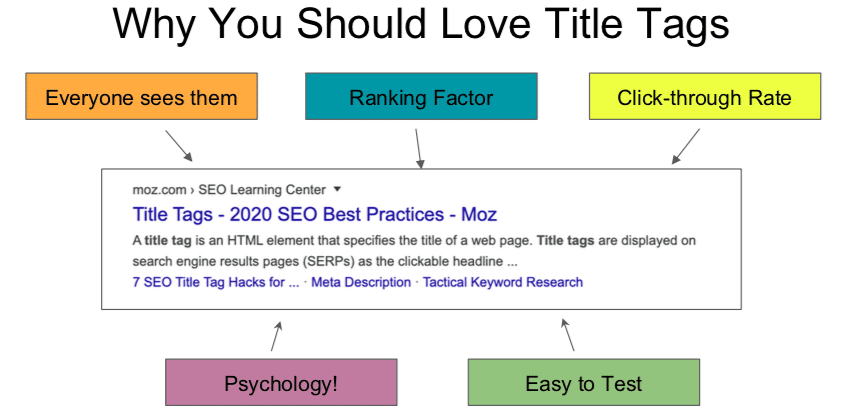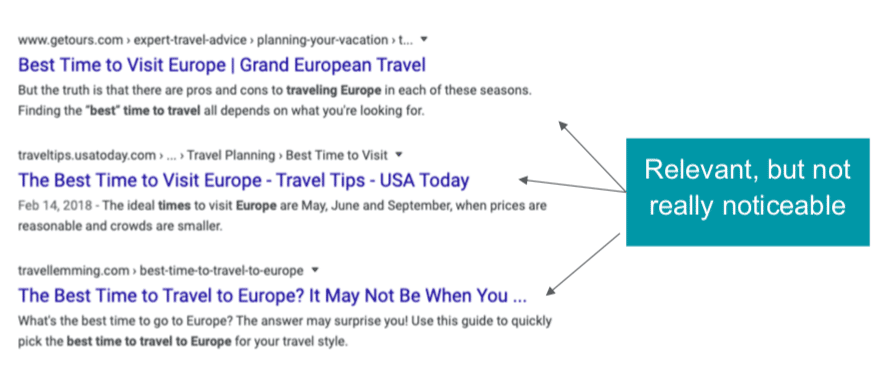
For many search marketers, title tags are one of the first-learned elements of the SEO’s toolkit. Unfortunately, that leads many to toss off title tag optimization as a beginner’s tactic.
During his presentation on Advanced Title Tag Optimization at SMX Next last month, Moz SEO consultant Cyrus Shepard explained why title tags are a critical component of SEO – and how when done correctly, can provide massive value for searchers and businesses.
In a crash course on title tag optimization, Shepard discusses why tags aren’t just for beginners and offers practical techniques – and what to avoid – in order to boost click-through rate (CTR) and earn more traffic.
Why are title tags important?
Title tags are the clickable headline that shows up on the SERP. Dictated by an HTML element that reflects the title of a web page, these tags are designed to help search engines understand the content of the page. There are key reasons why title tags are important, Shepard emphasized.
- It’s the first thing someone sees when conducting a search. “People may ignore your content, they may skim over it, they may ignore your meta description, your bread crumbs. But everybody, when they do a Google search, sees your title tag as the number one decision,” Shepard said.
- Title tags are a ranking factor. Shepard explained that Moz has been “studying the correlation of title tag signals to rankings over the years,” and despite a slowdown in correlations, title tags still influence click-through rate. “No matter what you do, the title tag more than any other element that displays in the SERPs influences whether or not people are going to click your result.”
- A mix of science and psychology. Even if a title tag doesn’t help you rank, it can still be a critical touchpoint to entice people into clicking. With the right language and messaging, title tags can play into a searcher’s curiosity and answer the question
- Title tags are easy to test. “You can change your title tag, go to Google Search Console, recrawl, reindex the URL, and see the changes in Google search results, sometimes within minutes,” Shepard said. From there, SEOs can examine the performance over the next few days to it had an effect. “And also, if things don’t work out, you can easily change your title tag back,” he added.
Going beyond the title tag basics
For beginners in SEO, there are a few general ground rules for when you’re just starting out with title tags. Shepard said, for example, “We know that we only want one title per page, that the title should be relatively short – 50 to 60 characters – the title should be unique, meaning it shouldn’t be a duplicate of other titles on your site.”
Other important considerations: use your target keywords (but avoid stuffing) and write compelling copy that answers the user’s query and will entice them to click through.
How to write compelling titles
Shepard uses the acronym NPR (yes, like the news organization) to help guide the thought process behind writing compelling headlines.
N = Noticeable
P = Promising
R = Relevant
Noticeable. In the below example of a Google search result for the best time to visit Europe, the title tags essentially all say the same thing. “I have to admit they’re a little uninspiring,” Shepard said. “There is nothing noticeable about these results. They’re just using the keyword but there’s nothing enticing me to click. There’s nothing to differentiate one of these results from any other result.”
Promising. “When a title is promising, it tells you what you should expect when you click. It goes beyond the keyword to promise you something to satisfy an emotional need. And good titles typically offer this,” Shepard explained.
When writing title tags, SEOs should think about how to use promising language to satisfy those needs as people search. He offers six ways to make title tags more promising for searchers:
- Surprise them
- Thrill them
- Impress them
- Educate them
- Reassure them
- Help them
“Even if you’re selling, you know, blenders. You can try to surprise people, thrill them, and impress them. They’re not just looking for blenders. They want something extra. Give them that in the title and you can entice the click. It’s hard to do, but you can do it,” Shepard said.
Relevancy. Without relevancy, the elements of ‘noticeable’ and ‘promising’ can be easily diluted. Searchers are looking for results that are relevant to their intent, Shepard explained.
In the below example, he demonstrates the difference between a relevant and non-relevant title tag for a search related to Target coupons. “The second result was a Target ads manufacturer. That’s not what I’m looking for. That’s not the promise that I want. I want the target promo codes and coupons,” he added.
The recipe for Systematic Success
Shepard outlined the “rules” for how he approaches title tag audits in five steps, using it as high-level guidance to “win at title tags nearly every single time.”
- There are zero foolproof formulas. A one-size-fits-all formula doesn’t exist – but it’s important for SEOs to understand that experimentation is a key component of finding success with title tags. It’s all about “finding out what works for you and your audience,” Shepard said.
- Test ideas to find those that yield six statistically significant gains. Develop a hypothesis, set goals and expectations, and use the NPR model to identify the biggest variation. Testing is a necessary strategy for title tags, according to Shepard.
- Collateral damage. “There is going to be some unintended consequences,” he warned. There’s no guarantee that implementing a title tag test will result in steady traffic gains but it’s important to make room for potential losses as you continue testing.
- Keep the winners – and learn from them. Enough said.
- Lose the losers. If you change the title tag and it goes bad, Shepard said, you can always revert back to the better performing original.
The post Advanced tactics for SEO title tag optimization appeared first on Search Engine Land.
Source: IAB



